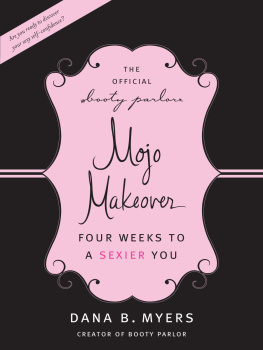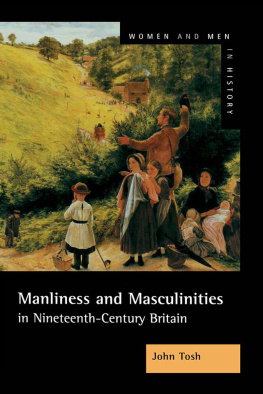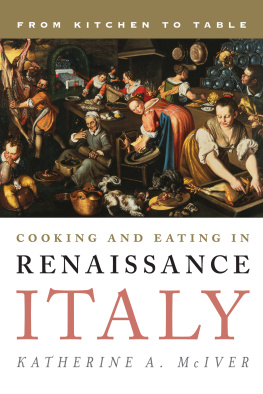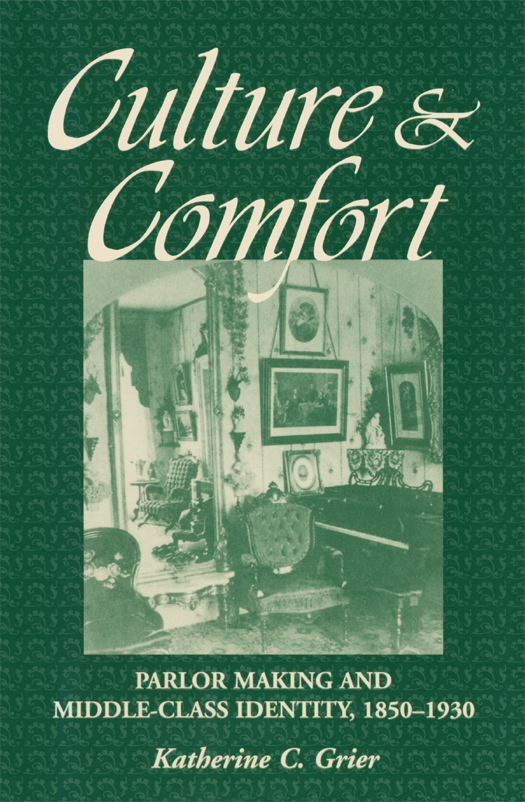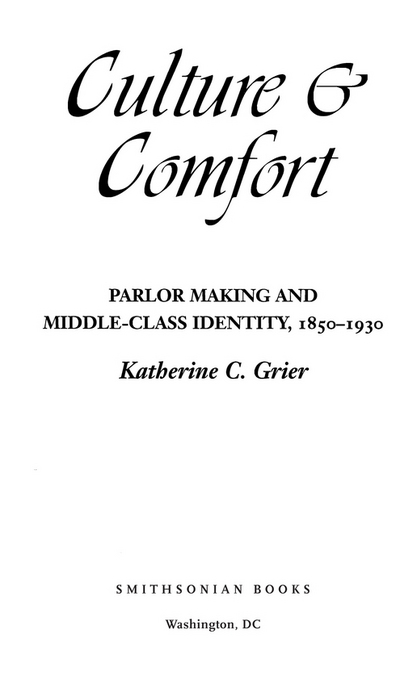1988, 2010 by the Strong Museum
All rights reserved
The original version of this book was published by The Strong Museum in conjunction with an exhibition entitled Culture and Comfort: People, Parlors, and Upholstery, 18501930, on view from 8 September 1988 to 16 January 1989.
Copy editor: D. Teddy Diggs
Production editor: Duke Johns
Designer: Kathleen Sims
Library of Congress Cataloging-in-Publication Data
Grier, Katherine C., 1953
Culture and comfort : parlor making and middle-class identity, 18501930 / Katherine C. Grier.
p. cm.
Revised and slightly condensed version of Culture and comfort. Rochester, N.Y. : Strong Museum, C 1988.
eISBN: 978-1-58834-347-5
1. Material cultureUnited States. 2. Living roomsUnited StatesHistory.
3. UpholsteryUnited StatesHistory. 4. Middle classUnited StatesHistory.
5. United StatesSocial life and customs19th century. 6. United StatesSocial life and customs18651918. 7. United StatesSocial life and customs19181945.
I. Grier, Katherine C., 1953 Culture & comfort. II. Title.
E166.G83 1997
392.36dc20 96-43927
British Library Cataloguing-in-Publication Data available.
For permission to reproduce illustrations appearing in this book, please correspond directly with the owners of the works, as listed in the individual captions. Smithsonian Books does not retain reproduction rights for these illustrations individually or maintain a file of addresses for photo sources.
v3.1
Contents
Preface
This book is about the waxing and waning of the Victorian parlor, a room whose elaborate decor and accompanying social performances seem, from the perspective of the late twentieth century, emblematic of the artifice, even phoniness, of Victorian culture. It is the story of how tens of thousands of middle-class American families devoted their financial and emotional resources to create rooms that none of them needed, strictly speaking, and that some of them seem rarely to have used. But bare necessity was not the point. Parlor-making families were participants in a rapidly commercializing world in which readily available goodscenter tables, window draperies, and sets of matching chairscould make manifest core cultural ideals that were, supposedly, timeless and beyond the reach of transient consumer tastes. And parlors were settings that allowed Victorian Americans to represent themselves as full participants in their world. The convention-laden contents of parlors, which had roots as much in the gala salon of elite houses as in the old-fashioned best room of modest dwellings in the previous century, were constant reminders of what Victorian culture valued highly: the principles of gentility and domesticity, along with the material refinement that inevitably accompanied civilized progress.
Gentility and domesticity were also at odds, however, and the tension was something that middle-class people learned to negotiate in both their consumer choices and their public social performances. The details of many families negotiations with a contradictory public discourse on middle-class identity are often beyond recovery. However, the general outlines of the debates can be reconstructed through the hectoring voices of several generations of domestic advisers and, more important, through the artifacts themselvesthe furnishings, the trade catalogs, the popular prints and illustrations, and the photographs that ordinary people made of their own parlors. Taken together, these material documents reveal the ideals and realities of parlor making in middle-class households as consumers balanced their budgets and dreams to create a representation of their desired public facade in a private room.
The word culture always vibrates with more than one meaning, and in this text I use it in two senses. The first, an anthropological conception of a group of people joined by their manipulation of a common system of symbols, underlies my general discussion of Victorianism, the transatlantic culture of the middle classes in the industrializing, commercializing nineteenth century. But the culture of this books title is also my shorthand for gentility, the international standard of personal excellenceindeed an international system of material symbols from wallpaper to tea tablesthat first guided the social behavior and consumption habits of Anglo-American elites in the eighteenth century. It is difficult to overstate the power of this ideal, precisely because of its vision of lifes possibilities. And gentility continued to shape Victorian culture in profound ways. Its authority even lingered into the twentieth century with the generations who were educated in its standards of manners, deportment, and taste.
Gentilitys focus on fashionable consumption and self-presentation was tempered by a second cultural position. A highly self-conscious domestic ideal asserted that middle-class family life lay outside the shallow world of purchasing an identity, and its apologists regarded the fashion-consciousness of gentility with suspicion. I have labeled this position comfort. Ironically, the public debate over comfort was often ambivalent about the increasing number of consumer goods that actually made dwellings into places where time could be spent in a pleasurable physical state. The rhetoric of much advice literature of the time argued that comfort was much more than ease; it was a distinctively middle-class state of mind that elites with aristocratic tendencies and consumers enslaved to novelties such as parlor stoves could not begin to understand. As the apologists for middle-class comfort tried to define a distinctive approach to consuming household goods, the new kind of genteel parlor became a particular focus of their concern and advice.
Pushed and pulled between an interest in the pleasures and properties of fashionable living and a fear of its consequences, including economic
The original edition of this book, titled Culture and Comfort: People, Parlors, and Upholstery, 18501930, was a big, heavily illustrated text intended both to document the contents of an exhibition of the same title and to stand as a work of scholarship after the five-month run of the exhibition at The Strong Museum in Rochester, New York. I created chapters to fill a variety of purposes, from explaining the specific elements of window coverings to establishing the sources of the parlor ideal, in an effort to serve the multiple constituencies of readers interested in Victorian material culture. I wanted to offer an interpretive account of a particular moment in the material culture of American Victorianism. However, there was no reference book for textile furnishings of the second half of the nineteenth and the early twentieth centuries, and little had been published on the subject. I needed to provide a basic guide to identifying the textile furnishings that were fundamental to the appearance of middle-class interiors between 1850 and 1930 yet were now misunderstood, undervalued, uncataloged, and disappearing fast because of their inherent fragility and the unintentional disregard of museums and collectors. I believe that the exhibition and the original edition of Culture and Comfort were successful in encouraging the preservation of these cultural artifacts, an outcome in which I have found real satisfaction.
I also faced the knotty problem of defining what a work of material culture studies should be. Although standards for excellence had been established in architecture and decorative arts, following formulas taken largely from art history, archaeology, and folklife studies, my work combined forms of evidence and ways of thinking that had been used to good purpose in social history (particularly as practiced by a few history museums like The Strong Museum), cultural anthropology, and that genre of art history concerned with reception and aesthetic experience as a social phenomenon. I also decided to give full scholarly attention to objects that had become, in their time, commoneven ordinary. Most of the pieces that drew my interest in the collection of The Strong Museum and other museums were neither high style nor folk, as I understand those terms. Rather they were part of a new middle-class material vernacular that tried to blend the conventions of gentility and domesticity, the two great poles of cultural meaning that I have labeled culture and comfort, as they were made manifest through coded design and materials in individual objects and assemblages of consumer goods.


